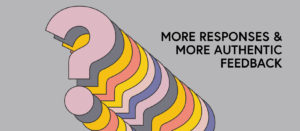Here’s What You’re Doing Wrong With Your Customer Surveys

And 3 easy ways to fix them for enhanced customer experience & brand engagement.

The following blog post was written by Maggy Stewart, Graphic Designer & Marketing Coordinator at RMS.
It happens every day and most of us, as ever-evolving consumers, are so used to it that we think nothing of it. After you hit the check out with your shopping cart full of goods, you’re inundated with a cartload of offers and experience surveys tied to incentives. Experience surveys (like those on receipts and in your inbox) offer discounts on your future purchases, retail questionnaires entice you with personalized percentages off your next visit, and the list (or receipt) goes on.
But recent studies share that although retailers initially look to these surveys as a means of improving their customer service and in turn their customers’ experience, they’re often a waste of time (and receipt paper).
The reason? A majority of retail and customer satisfaction surveys are flawed as far as approval ratings go. Gathering biased or inaccurate data, and too much of it, is a common pitfall. Adding insult to injury is how difficult it can sometimes be for customers to access the survey. And how does this happen? Many retailers are asking way too many questions, and these questions are often leading. Preceding that feedback with the offer of a reward can easily generate a bias before the individual even begins taking the survey. This incentivizing can sometimes render the organization’s satisfaction ratings as useless, and the sad part is that while it adds no value to the brand, it can actually do damage to it, according to Forbes. Yikes.
The trouble with this is that many retailers and businesses actually want to hear about their customers’ experiences, and a platform for a collective dialog has the tremendous ability to enhance a brand. So how should retailers and businesses properly execute a customer satisfaction survey that’s accurately developed to provide honest insight and answer burning commerce questions which help plan for future growth and investments?
Enhance engagement, enhance response rates

Long surveys can be a bear — not only to design, but for the consumer to participate in as well. Soliciting feedback in a drawn-out, boring way gives the customer no further inspiration to sit down and fill out a survey that could take longer than the few minutes advertised. And the last thing you want to do is frustrate an engaged customer while they’re in the middle of filling out your customer satisfaction survey. Seems like this could do more harm than the good it was intended to do, right? Response rates will continue to drop if consumers deem surveys as meaningless and time-consuming. Simplify your survey to get authentic feedback without the participant rushing through to reach the finish line — better yet, leverage the Net Promoter Score framework and gather feedback properly, with empathy, through an honest and engaged connection, and in the moment.
Avoid leading

In the case of a customer satisfaction survey, it’s best to replace leading questions with open-ended ones. Many brands tend to lead the customer toward an answer they want to hear. What’s the point in conducting the survey in the first place? Embrace open communication by eliminating bias and providing open text fields to gather fresh and original responses. Listen to what they’re sharing, respond if necessary, and thank them for their time. Because the time they took to tell you about their experience is as valuable as the time you spent implementing the survey.
Make the survey easily accessible

The easier it is for a customer to take your survey, the better. Your response rates will go up and the need to over-incentivize will diminish. Why? If you’re looking for quality answers to enhance your product or service, gathering information in-the-moment can prove to be beneficial—the experience is fresh in the participant’s mind, and their feedback can easily be gathered then and there. When you capture them at the right place and at the right time, the need to over-incentivize or push offers will diminish and you have the capability to attract truthful responses without having to focus so hard on getting as many people as possible to participate in the survey. Capturing your customers’ opinions in a meaningful and engaging way, and in the moment, means they’re more likely to give you the honest and valuable information you’re looking for, without tarnishing it through reward gimmicks and exhaustive questionnaires. You’ll find that if people can access your survey via a simpler route, it tends to have this unique trickle-down effect.
Customer experience surveys are highly valuable and necessary to gauge and improve brand interaction and growth. Keep this in mind: engagement is key. People don’t have the time or plain desire to give you every detail. Avoid exhaustion and promote engagement by avoiding redundant, unnecessary questions and capture their honest feedback immediately after they’ve had an experience to share — keep it short, be open to communication and thank them for their contribution and input.
RMS is a full-service market research and consulting firm located near Syracuse, New York. If you are interested in learning more about our market research and customer experience survey capabilities, please contact Sandy Baker, our Vice President of Corporate Development at SandyB@RMSresults.com or by calling 866.567.5422.